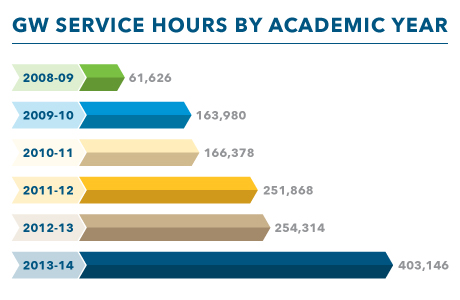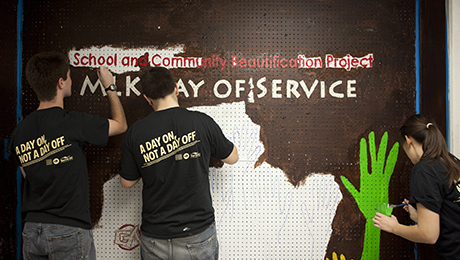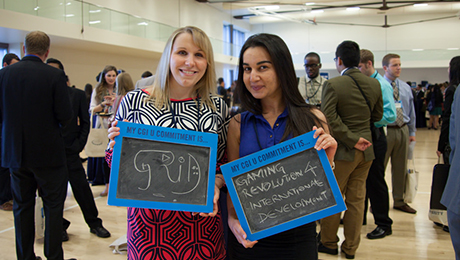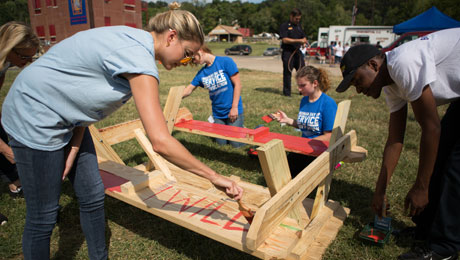By James Irwin
Seven years after President Steven Knapp organized the committee that would become the Center for Civic Engagement and Public Service and five years after First Lady Michelle Obama issued a passionate challenge for increased community involvement, service at the George Washington University has evolved beyond a quality of the institution and into one of its central traits.
GW amassed 403,146 service hours during the 2013-14 academic year, more than four times the original challenge goal of 100,000 hours Mrs. Obama issued in 2009.
"Service is a hallmark of our culture," said Amy Cohen, executive director of the Center for Civic Engagement and Public Service. "Civic engagement, citizenship and leadership are integrated across the university."
Service at GW has become a large enterprise. Over the past five years, the university has compiled 1.24 million volunteer hours in communities around the world. If GW service were a business, its output over the past half-decade would translate to a company with 118 full-time employees*.
*Based on the Office of Personnel Management’s 2,087-hour work year

GW amassed more than 400,000 service hours during the most recent academic year, more than four times the 100,000-hour challenge goal issued by First Lady Michelle Obama in 2009.
Beyond the data exists a perceptible shift in the way Colonials engage in civic efforts. Immersive volunteer opportunities have expanded, new academic service-learning courses are being created, and GW continues to provide new avenues for social entrepreneurship. Service at GW is more than free work and an experience; it empowers communities and provides volunteers with tools relevant to their future careers.
A hub for civic engagement
Kirk Wilson is one of those volunteers. As a freshman in 2011, he was considering transferring out of the university when a classmate invited him to attend a service event hosted by the AnBryce Foundation, which provides educational opportunities for underserved youth and is a host for GW’s DC Reads program. Mr. Wilson spent the day working with teenage students. He knew, almost immediately, that he couldn’t leave.
“That one day flipped my whole college experience,” he said. “Service, literally, kept me at GW.”
Mr. Wilson, who graduated from the Columbian College of Arts and Sciences Sunday, dove headfirst into programs offered by the Center for Civic Engagement and Public Service, including GW Alternative Breaks, Community Building Community and the Public Service Grant Commission. He’s one of thousands of GW students who have established community connections through service. The engageDC program (formerly the Neighbors Project) assigns 10 GW students as site leaders for volunteers at nonprofit organizations in the D.C. community. GW Jumpstart, a national AmeriCorps program that trains and places college students in preschools, has a large cohort of volunteers, each of whom serves around 300 hours annually. The volunteers who traveled on trips through GW Alternative Breaks this semester—including Mr. Wilson—accumulated 14,800 hours of service in 17 communities worldwide.
 GW students participate in a beautification project at Ballou High School during MLK Day of Service, one of many large-scale service projects organized by the Center for Civic Engagement and Public Service.
GW students participate in a beautification project at Ballou High School during MLK Day of Service, one of many large-scale service projects organized by the Center for Civic Engagement and Public Service.
“Students love these programs, and not just because they are doing service for a day or a week,” Ms. Cohen said. “They are doing education prep, multi-semester, multi-year service. They immerse themselves in a culture.”
Programs in the Center for Civic Engagement and Public Service represent a major avenue for volunteers—17 percent of all hours amassed during the last academic year came through opportunities organized by Ms. Cohen’s office. Growth of service through immersive programs like Jumpstart is one reason GW not only increased its overall hours but has seen a large jump in students who qualify for the President’s Volunteer Service Award by accumulating more than 100 hours of service in a year. GW reported 269 students achieving this status in 2012-13. In 2013-14 the number increased to 618.
“The reason we have so many service hours is because people want to do it,” Mr. Wilson said. “There’s no mandate. It’s something we willingly, actively and happily do.”
An expanding culture of service
Service exists throughout the GW community. According to the Center for Student Engagement, 90 of 345 student organizations (not including the 53 located in Greek Life) identify “advocacy and awareness” or “civic engagement” as their primary focus. Fraternities and sororities, almost all of which have associated philanthropic partnerships, amassed 61,549 service hours in 2013-14. GW student-athletes have contributed more than 16,000 hours of service the past two years.
The expansion of overall hours is the result of a collective effort.
Service through academics—including the GW Law School Pro Bono Program and academic service-learning courses across the university’s 10 schools and colleges—is one of the fastest-growing areas of civic engagement at GW, increasing from 41 courses two years ago to 67 this year. History professor Chris Klemek’s “Washington D.C.: History, Culture, Politics” course has evolved from a traditional reading-lecture-discussion format into Digital DC , the first course designated by the Columbian College for civic engagement credit and the first service-learning class offered in the history department. Half the students in Dr. Klemek’s class are enrolled in the Early College Program, a partnership with the School Without Walls , a D.C. public high school located on the Foggy Bottom Campus.
 Single-day service events, philanthropic partnerships in the Division of Student Affairs and a
n increase in academic service-learning all contributed to GW's 400,000-plus hours of service during the 2013-14 academic year.
Single-day service events, philanthropic partnerships in the Division of Student Affairs and a
n increase in academic service-learning all contributed to GW's 400,000-plus hours of service during the 2013-14 academic year.
“Those students really invigorate that classroom,” he said. “The collaboration has led to a local history project and a digital humanities resource that engages the community.”
Dr. Klemek’s course is unique in material but familiar in mission. Phyllis Ryder, an associate professor of writing, teaches one of the longest-running service-learning courses at the university. “Writing for Social Change” examines the discourse and rhetoric of community organizers writing for social causes. Students work with specific community partners in the city—generally spending three to four hours a week on projects that improve their skills and enhance the organization.
“They come in as a cohort for a semester,” said Tiffani Ross, director of community outreach and training for Life Pieces to Masterpieces, one of the “Writing for Social Change” community partners. “But we’ve seen that students are introduced to us through Dr. Ryder’s course and choose to stay onboard for additional semesters.”
That’s an example of topical service-learning that sparks a stronger, longer commitment.
“For our students, service is not displacing academics,” Ms. Cohen said, “it’s part of their academics.”
Creating social change leaders
As coordinator of special projects in the Center for Civic Engagement and Public Service, Charles Basden, B.A. ’08, M.P.A. ’11, provides administrative support for the Public Service Grant Commission, a student-led social innovation fund. The emergence of problem-solving programs that blend service and professional development, he said, is creating a new generation of social entrepreneurs.
“Being civically engaged is beneficial to the volunteer,” Mr. Basden said. “Students gain the experience and also learn things very relevant to their professional development. We see this in areas like our involvement with the Clinton Global Initiative, with student entrepreneurs working on projects like Pedal Forward, which is running workshops in a school in D.C. as part of its business model for sustainable bike development .”

Caroline Bailey, left, and Mariam Adil were among 15 GW social entrepreneurs who attended the 2014 Clinton Global Initiative University annual meeting in February. They are developing video games as learning tools for international development projects. (Mike Tindle/Clinton Global Initiative)
GWupstart, which launched last fall as part of the university’s participation in the Clinton Global Initiative, established GW’s membership in the CGI University Network and introduced a social entrepreneurship track in the GW Business Plan Competition. The university hosted CGI U’s annual meeting in 2012 and has seen an increase in participation, said Melanie Fedri, coordinator for the GWupstart Social Innovation Lab. In 2011, four GW students were accepted into CGI U. This year, 21 were accepted and 15 attended the annual meeting.
“Our programs support students in their desire to serve,” Mr. Basden said. “We’re not telling you what to do; in fact, you are telling us what you want to do.”
Ms. Ross sees that approach at Life Pieces to Masterpieces, where GW students who began by assisting teachers in the classroom advanced to service positions in finance, event planning, communications and grant writing.
“That forced us to revisit the opportunities we had,” Ms. Ross said. “We started looking at the needs of the organization and deciding where we wanted to see growth. From that we developed about seven different external operations or administrative roles. Now every volunteer is offered those opportunities.”
Social entrepreneurship is on the rise at GW, Ms. Cohen said. Lemonade Day, which teaches fundamentals of entrepreneurship while fostering financial literacy in 36 cities nationwide, came to D.C. when a GW student, Emily Massel, pitched the idea to the School of Business. Now it exists alongside MLK Day of Service and Freshman Day of Service as one of the largest single-day service events at the university.
The interdisciplinary approaches to civic engagement build the capacity for organizations.
“Nonprofits exist so that one day they don’t have to exist,” said Mr. Wilson, who advanced from classroom volunteer to program coordinator and now advisory council member at the AnBryce Foundation. “We recognize, as an academic institution, there are certain things we can do that change the whole system behind service. It’s one thing to serve the soup, but what you really want to do is shorten the line.”


